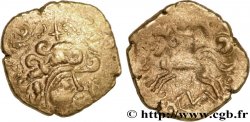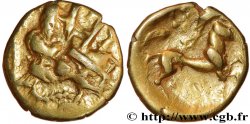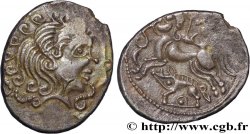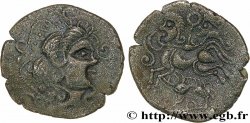bga_473796 - VENETI (Area of Vannes) Statère d’or à la petite mèche en cimier
Not available.
Item sold on our e-shop (2019)
Price : 4 850.00 €
Item sold on our e-shop (2019)
Price : 4 850.00 €
Type : Statère d’or à la petite mèche en cimier
Date: IIe siècle avant J.-C.
Mint name / Town : Vannes (56)
Metal : gold
Diameter : 20,5 mm
Orientation dies : 9 h.
Weight : 7,39 g.
Rarity : R3
Coments on the condition:
Flan un peu court et épais, mais régulier avec des types de droit et de revers bien centrés. Un petit plat est à signaler sur l’arrière de la tête au droit. Le revers est assez net sauf sur le corps du cheval et sur le personnage entre ses jambes
Catalogue references :
Obverse
Obverse legend : ANÉPIGRAPHE.
Obverse description : Petite tête à droite, les cheveux en grosses mèches, une petite mèche en cimier ; de la tête partent quatre cordons perlés, terminés chacun par une petite tête coupée.
Reverse
Reverse legend : ANÉPIGRAPHE.
Reverse description : Cheval androcéphale, bridé à droite ; au-dessus, l'aurige tient un lien ondulant relié à un étendard qui flotte devant la tête du cheval ; un personnage ailé sous le cheval.
Commentary
Ce statère est un intéressant spécimen de la série à la mèche en cimier. Le DT. 2120 est d’un style différent, mais c’est le seul avec ce motif en cimier. Notre monnaie a néanmoins une toute petite mèche alors que l’exemplaire BN. 6878 repris comme monnaie type a une très grosse mèche. Les revers sont sensiblement identiques.
Ces monnaies sont rares et recherchées !.
Ces monnaies sont rares et recherchées !.








 Report a mistake
Report a mistake Print the page
Print the page Share my selection
Share my selection Ask a question
Ask a question Consign / sell
Consign / sell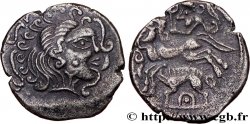
 Full data
Full data